Running a business with scattered apps often slows teams down. Information gets lost across spreadsheets, emails, and disconnected systems. The result? Missed deadlines, duplicated work, and decisions made without full visibility. For enterprise organizations, that lack of alignment translates into higher costs and slower execution.
This article explores the leading B2B SaaS enterprise software platforms built to unify people, projects, and processes in one digital workspace. These solutions streamline complex operations, help teams work with clarity, and create the transparency leaders need to move faster.
Along the way, we’ll highlight how platforms like monday work management gives teams a flexible, scalable platform to connect work across the enterprise—helping organizations reduce friction and focus on outcomes.
Try monday work managementWhat is B2B software?
B2B software refers to digital platforms that organizations use to plan, manage, and deliver work at scale. Unlike consumer apps designed for personal use, B2B solutions focus on collaboration, efficiency, and accountability across entire teams. They provide the structure and visibility needed to keep everyone aligned, no matter how large or distributed the company is.
The best B2B platforms act as a single source of truth. They bring together projects, processes, and data that might otherwise live in silos, making it easier to see progress and spot risks before they escalate. With automation, they reduce repetitive tasks that drain productivity. With integrations, they connect seamlessly to existing tools so data flows freely across the organization.
For fast-growing companies, scalability is essential. Leading platforms grow alongside your business, offering advanced permissions, enterprise-grade security, and analytics that adapt to evolving needs. The right software isn’t just about handling today’s workload — it’s about giving your team the confidence that the system will support tomorrow’s growth as well.
Moving from traditional software to modern platforms
Legacy business software often comes with heavy implementation costs, long timelines, and rigid licensing agreements. That approach no longer fits the pace of today’s enterprise environment. Modern platforms are designed to be flexible from the start. Teams can get up and running quickly, adapt workflows without code, and expand usage as priorities change.
Another key advantage is how updates are delivered. Instead of disruptive upgrades that require IT intervention, modern platforms roll out improvements automatically. New features and security enhancements appear seamlessly, allowing teams to focus on the work itself—not the maintenance behind it.
This subscription-based model also creates financial flexibility. Organizations can add or remove seats as teams expand or restructure, ensuring you only pay for what you need. By replacing rigid, one-time licenses with scalable subscriptions, companies free up resources to invest in innovation.
For enterprises under pressure to deliver results faster, modern B2B platforms provide the agility and visibility needed to stay competitive. They give leaders the clarity to make smarter decisions while giving employees the tools to collaborate without barriers. The outcome: less time fighting disconnected systems, and more time achieving meaningful results.
18 leading B2B SaaS platforms for enterprise teams
Choosing the right mix of enterprise platforms can transform how your company operates. The strongest solutions don’t just replace outdated systems—they connect teams, automate workflows, and scale as your organization grows.
The 18 platforms in this guide were selected for their enterprise-ready features, seamless integrations, and proven track record with large companies. Each one addresses common challenges, from misaligned communication to manual processes that slow teams down.
Think of these platforms as the connective tissue of your organization. By linking projects, people, and processes, they give leaders the clarity to make data-driven decisions while empowering employees to collaborate without friction.
Whether you’re consolidating a complex tech stack or filling gaps in your current workflows, this lineup highlights platforms that deliver measurable impact.
1. monday work management

monday work management connects projects, processes, and teams on one visual platform. It adapts to more than 200 use cases without requiring code, giving enterprises the flexibility to customize workflows while maintaining consistency across departments.
Best for: Teams that want to centralize work across departments while keeping the freedom to tweak workflows on the fly.
Key features:
- Multiple board views (Kanban, Gantt, timeline, calendar, workload, and more) so every teammate can see work the way they like best
- 200+ pre-built automation recipes to wipe out repetitive chores and keep cross-team hand-offs humming
- Built-in AI that can instantly create detailed project plans with AI-suggested tasks and phases, flag portfolio risks, and auto-categorize incoming requests
Powerful automations for your sales team
Supercharge your sales process with time-saving automations that eliminate busywork and keep your team focused on closing deals.
- Automatic lead assignment that routes new prospects to the right rep based on territory, deal size, or industry
- Smart follow-up reminders that trigger based on prospect engagement and deal stage
- Deal stage progression that automatically updates when specific activities are completed
200+ Integrations
Connect your entire tech stack to create a seamless workflow where data flows exactly where you need it, when you need it.
- Native integrations with tools you already love like Slack, Microsoft Teams, and Google Workspace
- Two-way sync with major CRMs, including Salesforce, HubSpot, and Pipedrive
- API access for custom connections to any platform in your ecosystem
Advanced AI features
Let AI handle the heavy lifting so your team can focus on strategy and relationship-building that drives real results.
- AI-powered meeting summaries that automatically capture action items and next steps
- Smart deal insights that analyze patterns to predict which opportunities are most likely to close
- Content generation for personalized outreach emails and follow-ups based on prospect data
Pricing (all plans require a 3-seat minimum):
- Free: $0 forever for up to 2 seats, 3 boards, and basic features
- Basic: $9 per seat/month: unlimited viewers, 5 GB storage, and a shareable dashboard for 1 board
- Standard: $12 per seat/month: timeline & Gantt views, guest access, dashboards combining up to 5 boards, plus 250 automation actions, 250 integration actions, and 250 AI credits per month
- Pro: $19 per seat/month: private boards, time tracking, dashboards spanning 10 boards, and 25,000 automation actions, 25,000 integration actions, and 500 AI credits per month
- Enterprise: Custom pricing: enterprise-grade security, advanced reporting, unlimited automations/integrations, and 1,000+ AI credits
- Annual billing knocks about 18 % off, and nonprofits snag extra discounts
Why it stands out:
- Crossed $1 B in annual recurring revenue with 245,000+ customers—proof it scales from startups to global enterprises
- Named a Leader in three 2024 Gartner Magic Quadrants: Marketing Work Management, Collaborative Work Management, and Adaptive Project Management & Reporting
- A Forrester Total Economic Impact study found customers saw positive ROI in under four months
- Users rave about its drag-and-drop ease and lively, visual interface—making project updates feel (almost) fun
2. Asana
Asana transforms scattered work into streamlined execution by connecting individual tasks to company-wide goals. The platform specializes in intuitive collaboration and flexible project visualization, making it ideal for teams that need clarity without complexity. With over 100,000 paying organizations trusting Asana, it’s become a go-to choice for teams seeking transparent work management.
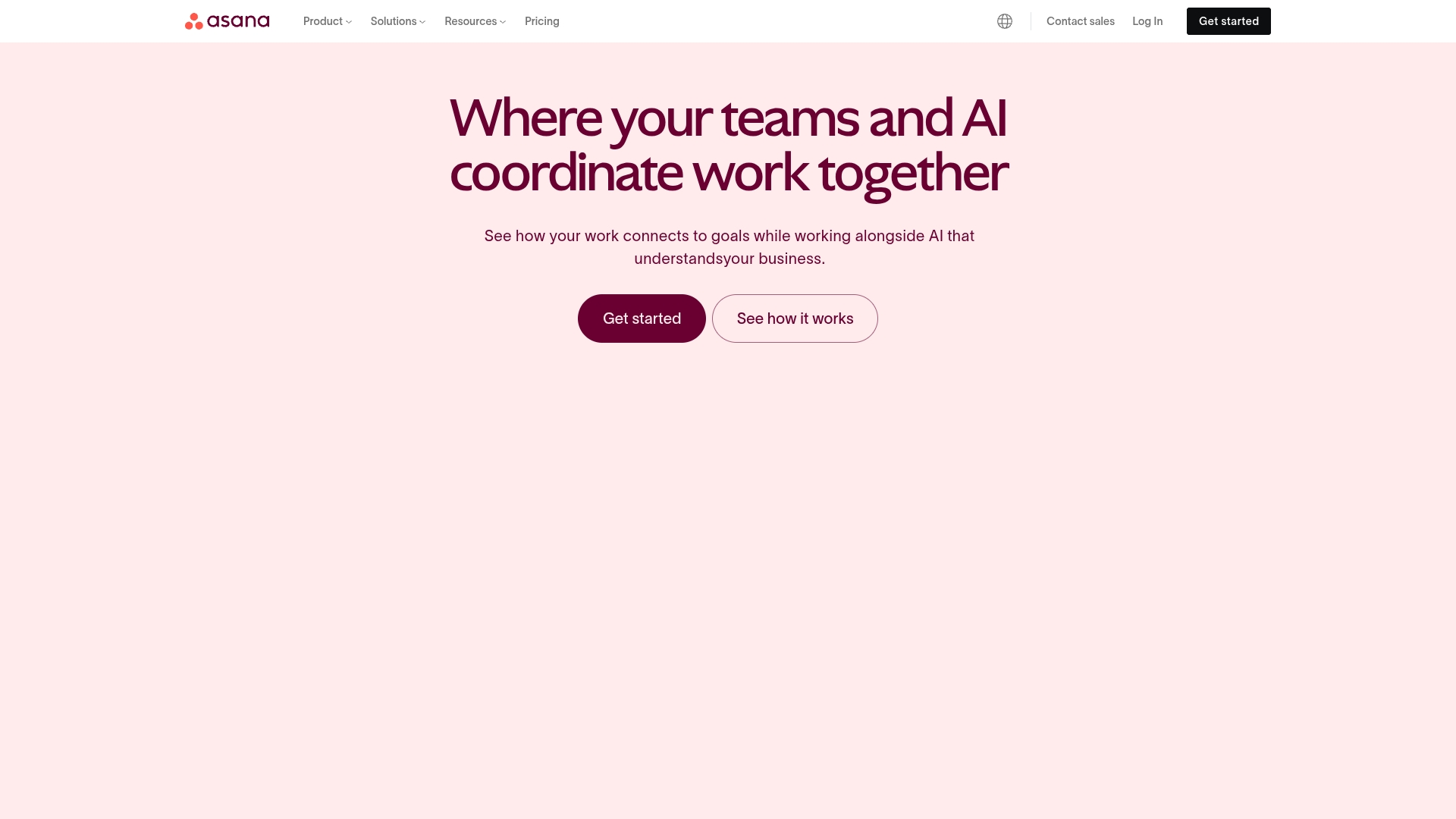
Best for: Teams seeking user-friendly work management software that connects daily tasks to strategic objectives while maintaining simplicity.
Key features:
- Multiple project views, including timeline (Gantt), board (Kanban), calendar, and list formats
- Goal tracking that links company objectives directly to project work
- 300+ integrations with popular tools like Slack, Google Workspace, and Microsoft Teams
Pricing:
- Basic: Free for up to 15 team members
- Premium: $10.99/month per user (billed annually)
- Business: $24.99/month per user (billed annually)
- Enterprise: Contact sales for custom pricing
Considerations:
- Tasks can only be assigned to one person, which limits collaborative work scenarios
- Advanced features like timeline view and custom fields are locked behind paid plans, making the free version somewhat restrictive for growing teams
3. Salesforce
Salesforce transforms customer relationships into revenue engines through its industry-leading CRM platform. The platform specializes in unifying sales, service, marketing, and analytics data, making it ideal for large enterprises managing complex customer journeys across multiple touchpoints.
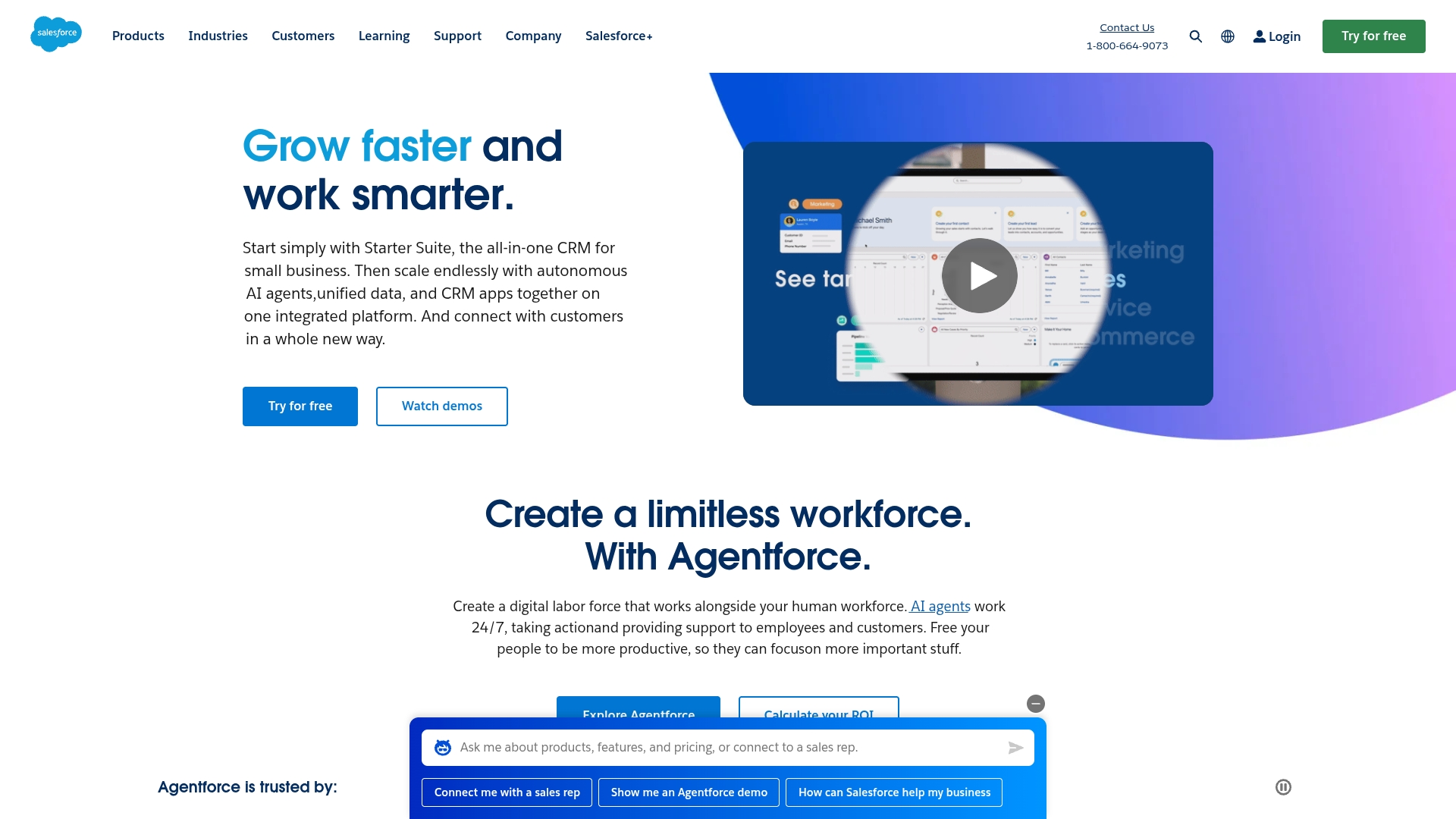
Best for: Large enterprises seeking a comprehensive CRM solution that integrates customer data management with advanced customization capabilities and AI-powered insights.
Key features:
- 360-degree customer view combining sales, service, marketing, and analytics data in one unified platform
- Einstein AI platform for predictive analytics, automated task management, and intelligent recommendations
- AppExchange marketplace with over 5,000 third-party applications for extensive platform customization
Pricing:
- Contact Salesforce sales for detailed pricing information
- Multiple product tiers available for Sales Cloud, Service Cloud, Marketing Cloud, and other solutions
- Most subscriptions require annual payment in advance
- Salesforce Starter available for monthly or annual contracts
Considerations:
- Steep learning curve due to platform complexity, especially for new users unfamiliar with CRM systems
- High total cost of ownership when factoring in required third-party apps for comprehensive functionality
4. HubSpot
HubSpot delivers an all-in-one CRM platform that helps businesses attract, engage, and delight customers through inbound marketing. By blending AI for B2B marketing automation, sales pipeline management, and customer service tools in one place, it’s a solid fit for small to mid-sized companies that don’t want to juggle a patchwork of apps.
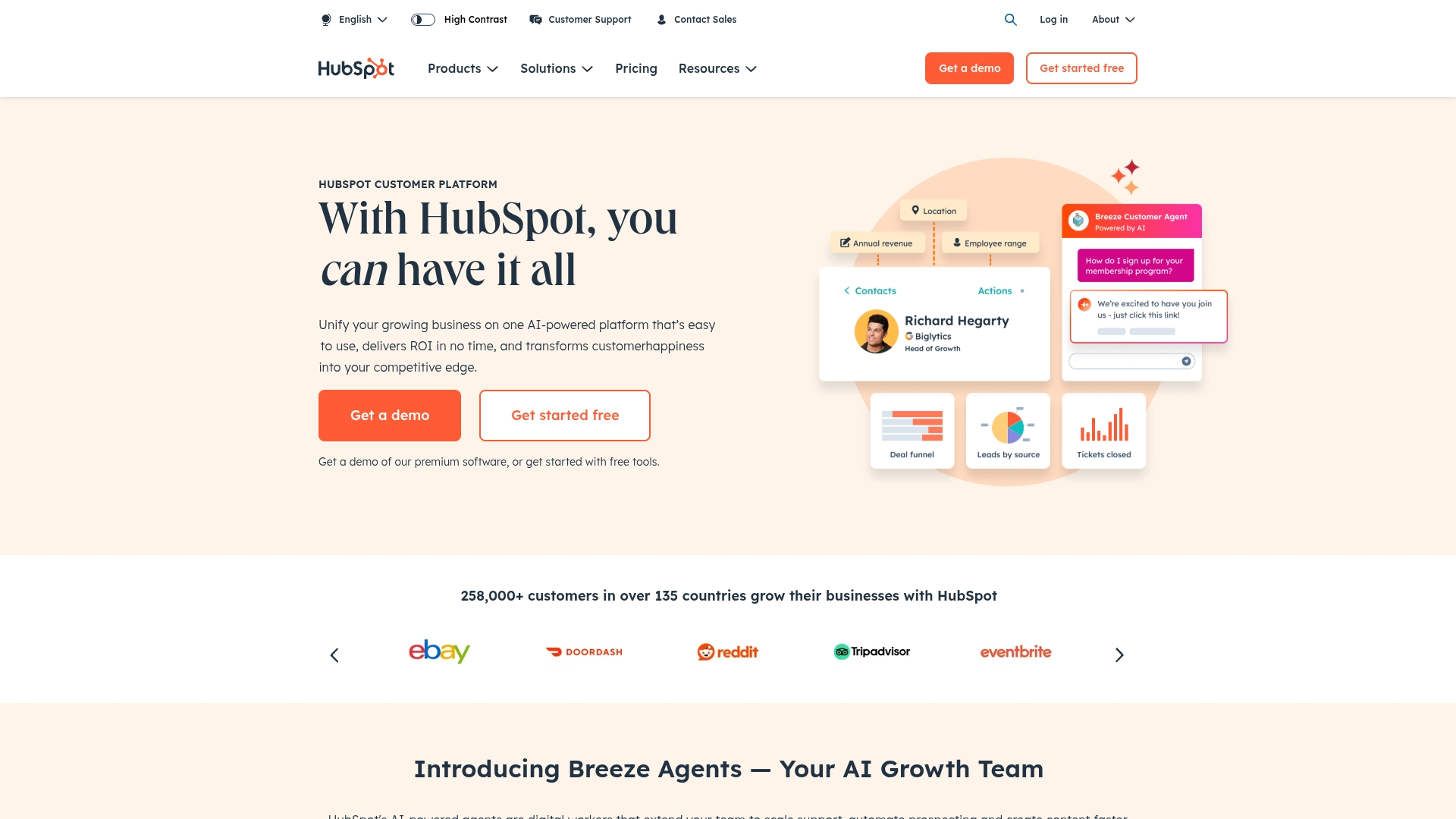
Best for: Teams that want a single, connected workspace for all customer-facing activities — no more tab-hopping between separate B2B tools.
Key features:
- Centralized task management built right into the CRM, so sales and marketing stay perfectly in sync
- Automated task creation triggered by workflows, emails, and calendar events—goodbye, manual busywork
- Real-time collaboration with task assignment and shared visibility, keeping everyone on the same page
Pricing:
- Free plan: Core CRM and basic task management to get started risk-free
- Starter plan: Adds deeper automation and reporting for growing teams
- Professional plan: Unlocks HubSpot Projects and other advanced work-management goodies
- Enterprise plan: Full-scale features, custom reporting, and extensive integrations for complex needs
Considerations:
- Project-management tools are solid for light to moderate work, but may feel limited compared to dedicated enterprise PM platforms
- Many of the flashier productivity features live in higher-tier plans, so budget-conscious teams should review tiers carefully before diving in
In short, HubSpot gives SMBs an intuitive, all-in-one growth engine—just keep an eye on which plan unlocks the features you need.
5. Wrike
Wrike delivers intelligent work management that transforms complex workflows into streamlined execution for teams across any industry. The platform specializes in deep customization and enterprise-grade security, making it ideal for mid-sized to large organizations managing intricate cross-functional projects. With AI-powered Work Intelligence and support for over 20,000 organizations worldwide, Wrike adapts to your unique processes rather than forcing you into rigid templates.
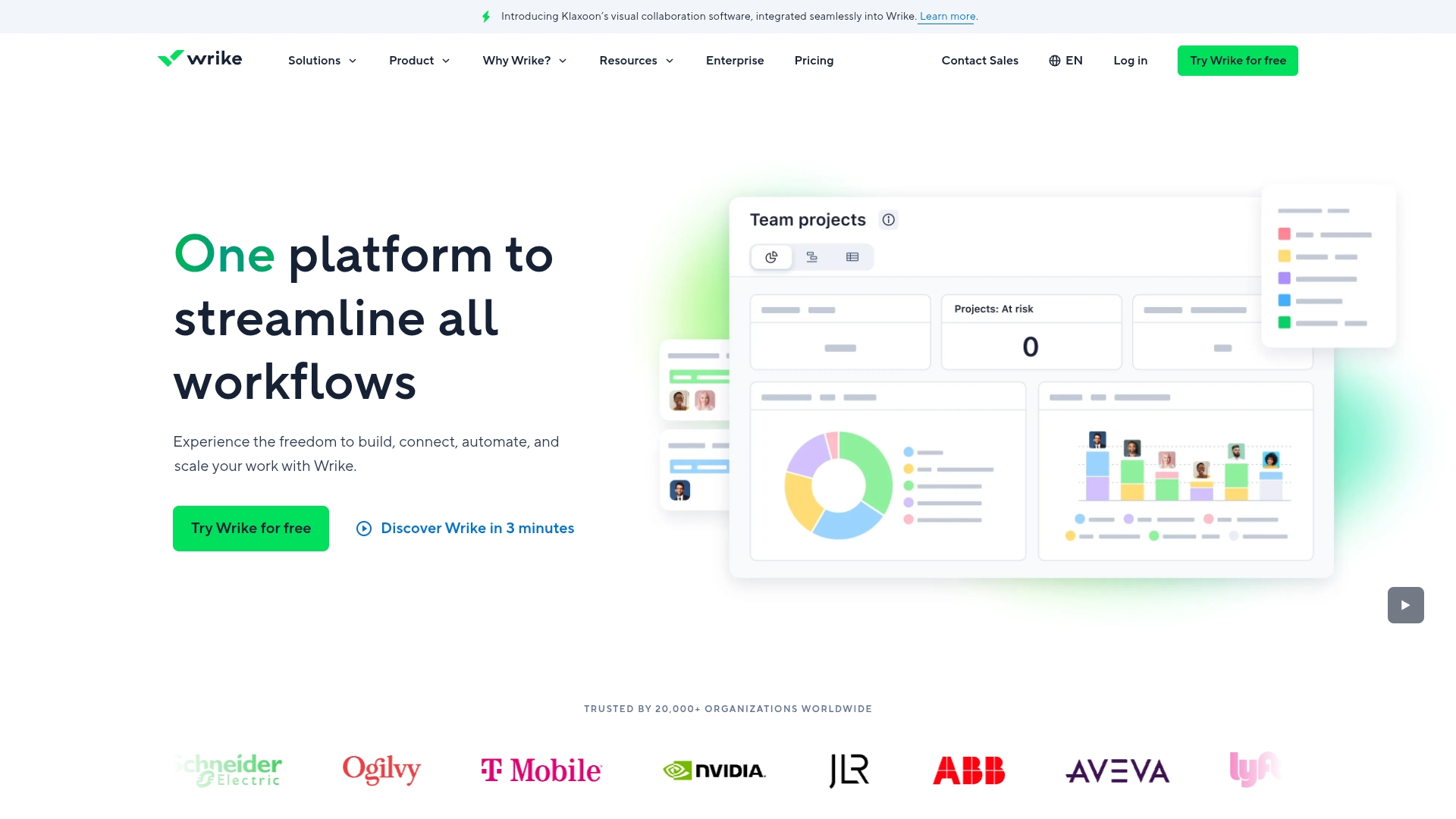
Best for: Organizations requiring highly customizable workflows with enterprise-level security and advanced project portfolio management capabilities.
Key features:
- Project portfolio management with real-time dashboards and resource allocation across multiple initiatives
- AI-powered Work Intelligence that predicts project risks, automates task creation, and generates actionable insights
- Custom item types and workflows that mirror your exact business processes beyond standard projects and tasks
Pricing:
- Free: $0/month for basic task and project management
- Team: $10/month per user (2-15 users) with dashboards, automations, and 2GB storage
- Business: $25/month per user (5-200 users) including advanced reporting, resource planning, and 5GB storage
- Enterprise: Custom pricing with SAML SSO, advanced permissions, and 10GB storage
- Pinnacle: Custom pricing for complex needs with advanced BI reporting and 15GB storage
- All paid plans include 14-day free trials with no credit card required
- Annual billing required for Business plans and above
Considerations:
- Extensive feature set can overwhelm smaller teams with simple project needs
- Premium capabilities are locked behind higher-tier plans, making advanced functionality expensive for growing team6. Trello
Trello turns scattered to-do’s into crystal-clear, drag-and-drop workflows with its signature Kanban-style boards. It’s built for folks who want to get organized fast—no dense menus or 40-page manuals required.
 Best for: Teams craving an intuitive, visual way to track work without heavyweight project-management bells and whistles.
Best for: Teams craving an intuitive, visual way to track work without heavyweight project-management bells and whistles.
Key features
- Kanban boards with cards you can customize and drag between columns
- Butler automation to wipe out repetitive tasks (goodbye, copy-paste!)
- A huge Power-Ups marketplace to plug in Slack, Google Drive, Jira, and more
Pricing (check Trello’s site for the latest details)
- Free – Ideal for solo users and very small teams
- Standard – Unlocks unlimited team boards and advanced checklists
- Premium – Adds Calendar, Timeline, Dashboard, and other pro views + enhanced Power-Ups
- Enterprise – Scales across the whole organization with advanced security and admin controls
Considerations
- No native Gantt charts, time tracking, or deep reporting—third-party Power-Ups are required
- Boards can get crowded when you’re juggling dozens of projects at once, so larger teams may need stricter naming conventions (or an additional PM platform)
7. ClickUp
ClickUp delivers an all-in-one productivity platform that consolidates tasks, documents, and team communication into a single workspace. The platform specializes in extreme customization and comprehensive feature sets, making it ideal for teams who want to replace multiple B2B software solutions with one unified system. With over 10 million users worldwide, ClickUp has become a go-to choice for businesses seeking to eliminate the chaos of juggling separate tools.
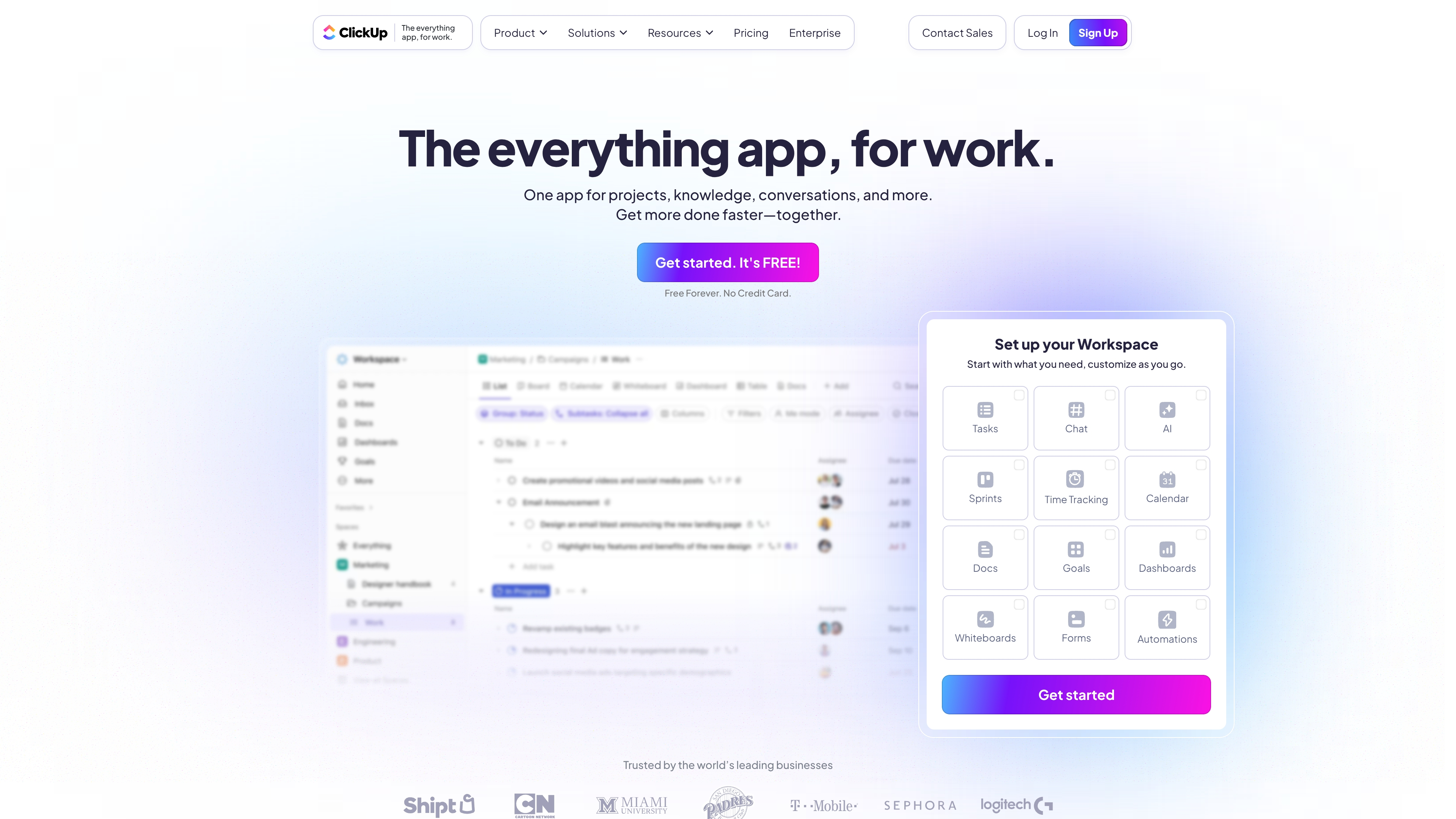
Best for: Teams seeking a highly customizable, all-in-one B2B software solution that can adapt to virtually any workflow or industry requirement.
Key features:
- Over 15 customizable views including Kanban boards, Gantt charts, and calendar layouts to visualize work exactly how your team prefers
- Collaborative document creation and editing with real-time commenting and version control for seamless team coordination
- Built-in goal tracking with OKRs and milestone management to align daily tasks with strategic business objectives
Pricing:
- Free Forever: $0/month (unlimited tasks and members, 60MB storage)
- Unlimited: $7/user/month (2GB storage per user, unlimited integrations, Gantt charts)
- Business: $12/user/month (unlimited storage, advanced dashboards, custom automations)
- Enterprise: Custom pricing (white labeling, advanced permissions, dedicated support)
- Discounts available for nonprofits, students, educators, and startups
Considerations:
- Steep learning curve due to extensive feature set can overwhelm new users and slow initial adoption
- Mobile app functionality is significantly limited compared to desktop version, with frequent synchronization issues reported by users
8. Smartsheet
Smartsheet turns sprawling, complex work into clean, automated workflows—all wrapped in a spreadsheet-like package your team already understands. With enterprise-grade security, limitless automation on higher tiers, and views that stretch from Gantt to Kanban, it’s a heavyweight option trusted by 80%+ of the Fortune 500.
Best for: Teams that crave spreadsheet software familiarity, yet need the power, governance, and scalability of an enterprise work-management platform.
Key features:
- Spreadsheet-style sheets plus Gantt, Kanban, and calendar views for flexible project tracking
- Unlimited automation on Business, Enterprise & Advanced plans—streamline approvals, alerts, and hand-offs without code
- Enterprise-grade security: encryption at rest/in transit, multifactor auth, granular admin controls, and compliance certifications
Pricing (billed monthly unless noted):
- Pro: $129 per member/month for 1–10 members; unlimited sheets, forms, reports, and 250 automations per month
- Business: $2,419 per member/month for 3+ members; unlimited automations, timeline view, and 1 TB attachment storage
- Enterprise: Custom per-member pricing for 10+ members; adds AI tools, SAML SSO, and unlimited attachment storage
- Advanced Work Management: Custom per-member pricing; bundles premium tools like Control Center, Dynamic View, and Data Shuttle
- Optional add-ons (Business & Enterprise): Dynamic View from $125/month and Data Shuttle from $20/month per member
Considerations:
- Advanced automations and resource management can take some training time to master
- Costs add up quickly for smaller teams—especially once premium add-ons enter the mix
If your organization needs spreadsheet-simple collaboration that scales to enterprise complexity, Smartsheet is a strong, configurable ally.
9. Airtable
Airtable turns the humble spreadsheet into a flexible, no-code and low-code database that can power almost any workflow—without forcing your team into heavyweight enterprise software. Think of it as the place where spreadsheet lovers, database pros, and app builders can finally high-five.
Best for: Teams that want a friendly, no-/low-code platform combining spreadsheet ease with database muscle and app-building superpowers.
Key features:
- 25+ field types (attachments, checkboxes, formulas, links, look-ups, etc.) with true relational linking
- Multiple “views” for the same data—Grid, Kanban, Calendar, Timeline, Gantt, Gallery, and more
- Built-in Automations (if-this-then-that workflows) plus scripting for deeper low-code logic
- Cobuilder (beta): generate full Airtable apps from plain-language prompts—AI does the heavy lifting
- AI features baked in (summaries, categorization, translations) with usage-based AI credits
- Robust API, standard & premium sync integrations, and an Extensions marketplace
- Works everywhere: modern web app, native iOS and Android, plus offline-friendly mobile views
- Enterprise-grade security: SSO/SAML, granular permissions, audit logs, DLP, and SOC 2 compliance
Pricing (per seat, billed annually unless noted):
- Free – $0
- Team – $20 ($24 month-to-month)
- Business – $45 ($54 month-to-month)
- Enterprise Scale – Custom
- Add-ons: Airtable AI, Portals, ProductCentral. Discounted plans available for nonprofits & education.
Considerations:
- There’s a learning curve for folks new to relational databases—especially when modeling complex linkages.
- Per-seat pricing can add up fast for large orgs compared with single-price project-management tools.
10. Microsoft Teams
Microsoft Teams transforms scattered workplace communication into a unified collaboration hub that keeps everyone connected and productive. The platform specializes in seamless Microsoft 365 integration, making it the go-to choice for organizations already invested in the Microsoft ecosystem. With over 320 million monthly active users, Teams has become the central nervous system for modern workplace collaboration.
Best for: Organizations seeking an all-in-one communication and collaboration platform that integrates deeply with Microsoft 365 tools.
Key features:
- Persistent chat channels organized by teams and projects with threaded conversations
- Enterprise-grade video conferencing with screen sharing, recording, and AI-powered meeting summaries
- Real-time document collaboration through integrated SharePoint and OneDrive access
Pricing:
- Microsoft 365 Personal: $9.99/month or $99.99/year (for one person)
- Microsoft 365 Family: $12.99/month or $129.99/year (for up to six people)
- Teams is included with all Microsoft 365 subscriptions at no additional cost
- Premium features available through Teams Premium add-on
Considerations:
- Interface can feel overwhelming for new users due to the extensive feature set and customization options
- Native project management capabilities are basic compared to dedicated b2b software solutions, requiring integration with Microsoft Planner or third-party tools for advanced functionality
11. Zoho CRM
Zoho CRM delivers comprehensive customer relationship management with seamless project integration for businesses ready to connect their sales pipeline directly to execution. The platform specializes in bridging the gap between winning deals and delivering results, making it ideal for service-based companies that need visibility from prospect to project completion.
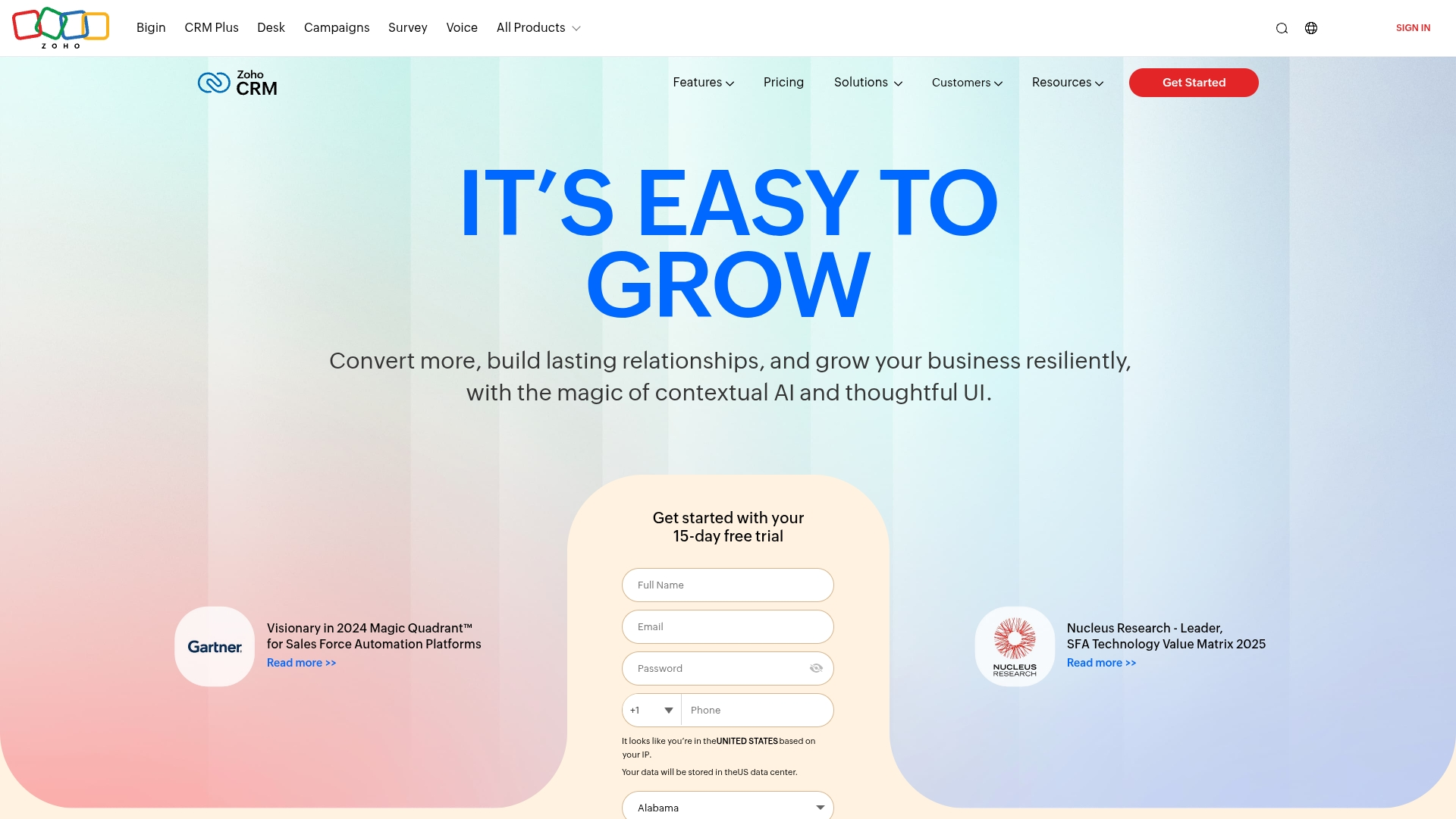
Best for: Small to medium-sized businesses seeking an integrated CRM and project management solution that automatically transforms won deals into trackable projects.
Key features:
- Automatic project creation from closed deals with seamless CRM-to-project workflow
- Comprehensive task management with Gantt charts, time tracking, and milestone planning
- AI-powered sales assistant (Zia) providing predictive analytics and intelligent insights
Pricing:
- Free Edition: Free for up to 3 users with basic CRM essentials
- Standard: $14/user/month (billed annually) with mass email and workflows
- Professional: $23/user/month (billed annually) including inventory management and webhooks
- Enterprise: $40/user/month (billed annually) with Zia AI and territory management
- Ultimate: $52/user/month (billed annually) featuring advanced analytics and customization
- Team Users: $9/user/month add-on for non-sales team members
Considerations:
- The extensive feature set can overwhelm new users, requiring significant time investment to master the platform
- Customer support response times have been inconsistent, particularly for users on lower-tier plans
12. Basecamp
Basecamp keeps project management refreshingly simple, giving teams one calm place to chat, plan, and share files—no tool overload required. It’s a favorite for small and midsize businesses that want to swap a tangle of apps for one tidy hub.
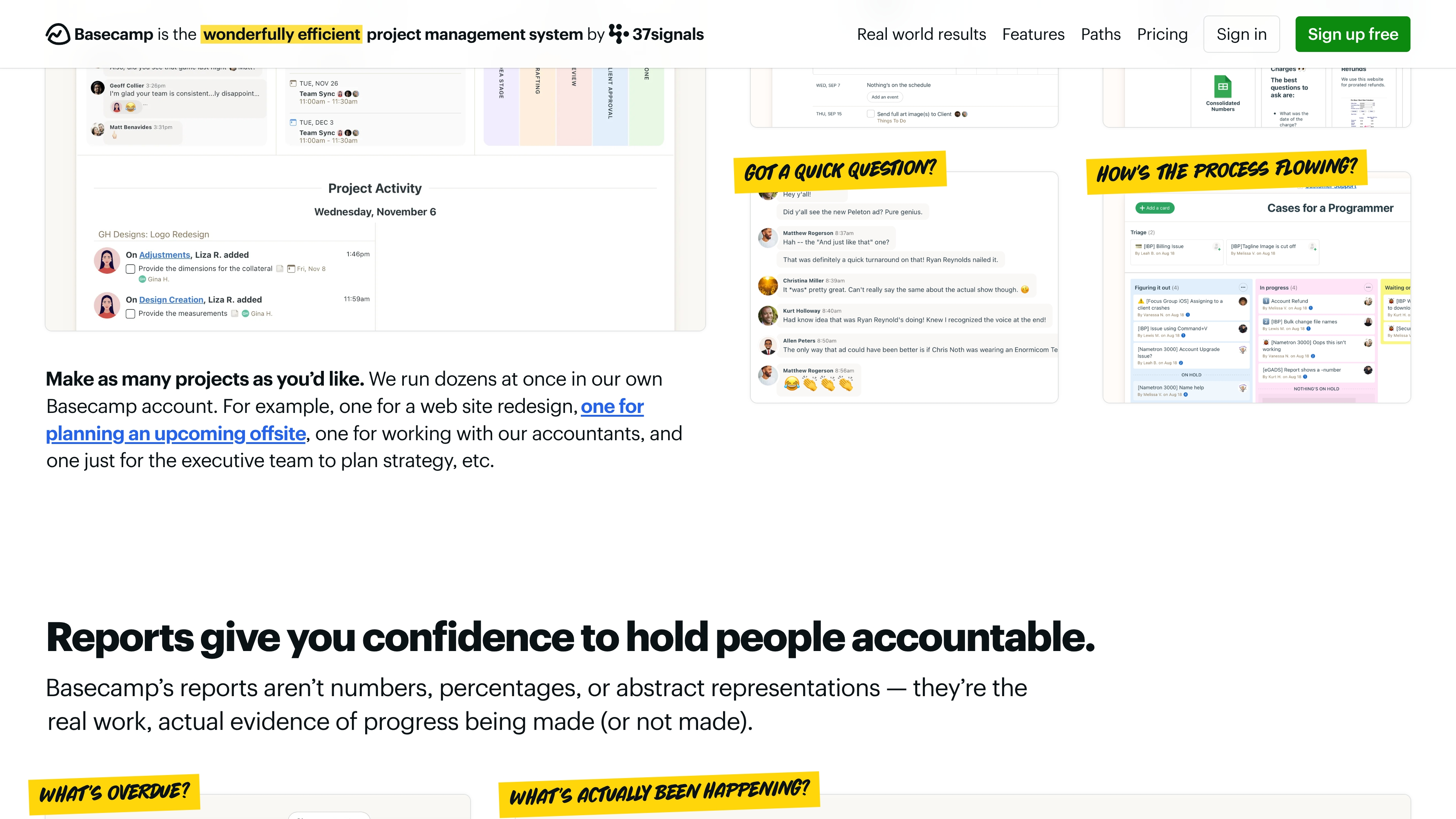
Best for: Teams looking for a streamlined, “everything-in-one-place” workspace without the extra bells and whistles that can slow you down.
Key features:
- Unified project spaces with message boards, to-do lists, schedules, and file storage
- Campfire real-time group chat for quick questions and instant decisions
- Card Table (Kanban board) to visualize tasks moving from “To-do” to “Done”
- Hill Charts that show whether work is still in problem-solving mode or cruising toward completion
- Client access that keeps approvals and feedback neat, secure, and out of your inbox
Pricing:
- Basecamp Free: $0 / month — 1 active project at a time and 1 GB storage (great for personal use or a tiny team)
- Basecamp Plus: $15 per user / month — unlimited projects, 500 GB storage, guests/clients free, 24/7/365 support, optional Timesheet & Admin Pro Pack upgrades
- Basecamp Pro Unlimited: $299 / month when billed annually ($349 month-to-month) — flat rate for unlimited users, 5 TB storage, priority support, personal onboarding, and Timesheet & Admin Pro Pack included
Considerations:
- Minimal customization—no native Gantt charts, task dependencies, or advanced time tracking
- The “less is more” philosophy can feel restrictive if you need heavyweight project-planning tools
13. Jira
Jira transforms complex software development workflows into streamlined agile processes that keep technical teams moving fast. The platform specializes in issue tracking and agile methodology support, making it the go-to choice for development teams who need robust project management capabilities. With its deep integration across the Atlassian ecosystem, Jira bridges the gap between technical and business teams seamlessly.
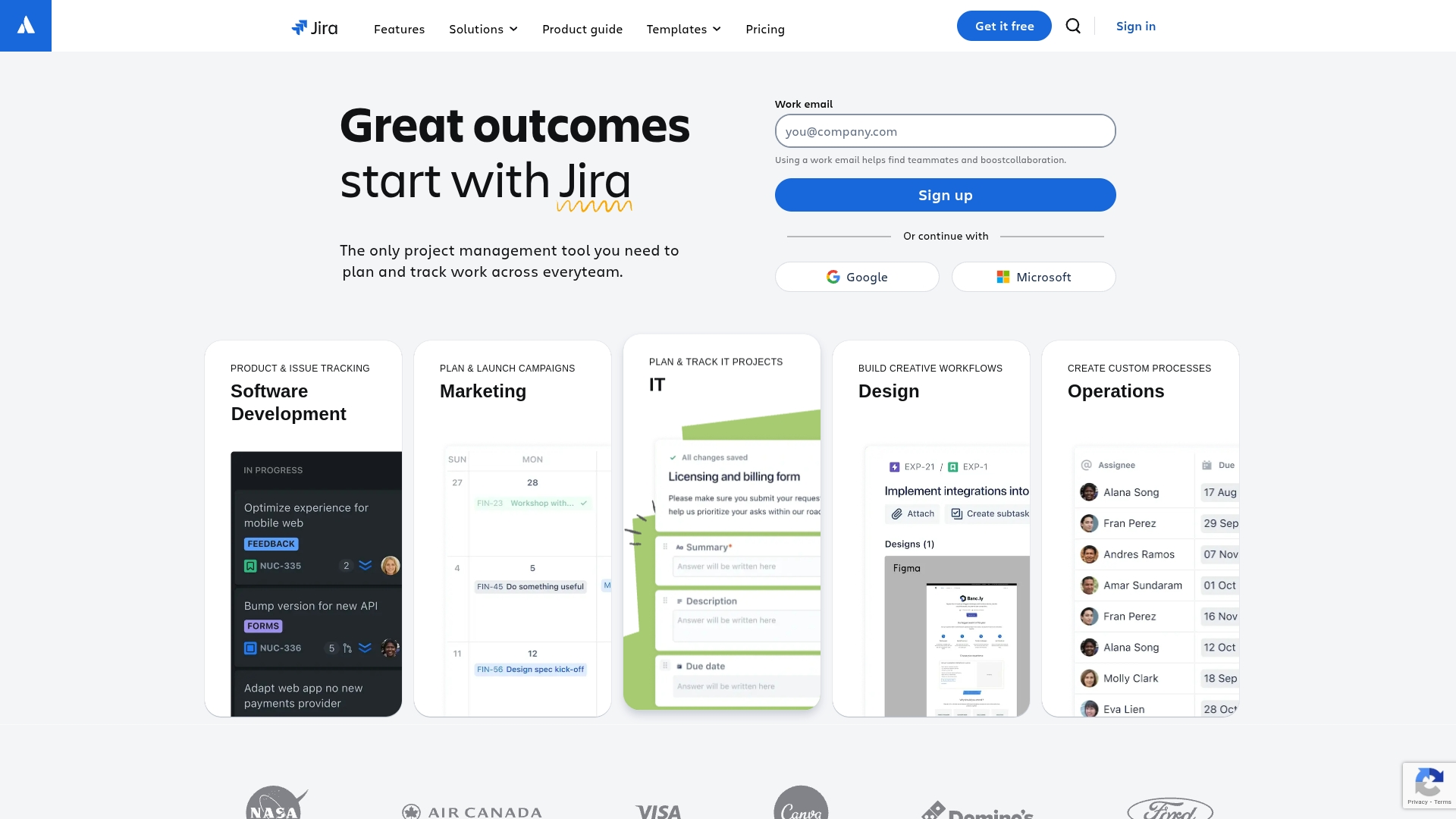
Best for: Development teams and technical organizations that need powerful issue tracking, agile project management, and seamless integration between software development and business operations.
Key features:
- Advanced issue tracking with customizable workflows that mirror your development processes
- Comprehensive agile methodology support including Scrum and Kanban boards with sprint planning
- Extensive integration ecosystem connecting development tools with business applications across the Atlassian suite
Pricing:
- Free: $0 for up to 10 users with 2 GB storage and basic features
- Standard: $7.53 per user per month with 250 GB storage and advanced permissions
- Premium: $13.53 per user per month with unlimited storage and AI-powered features
- Enterprise: Custom pricing with advanced analytics and enhanced security features
Considerations:
- The learning curve can be steep for non-technical teams, requiring significant onboarding time
- Interface complexity may overwhelm users who need simpler b2b software solutions for basic project management
14. Slack
Slack transforms team communication from scattered emails into organized, channel-based conversations that keep everyone connected and informed. The platform specializes in creating a digital headquarters where teams can collaborate in real-time, making it perfect for organizations looking to streamline communication while integrating their favorite work tools.
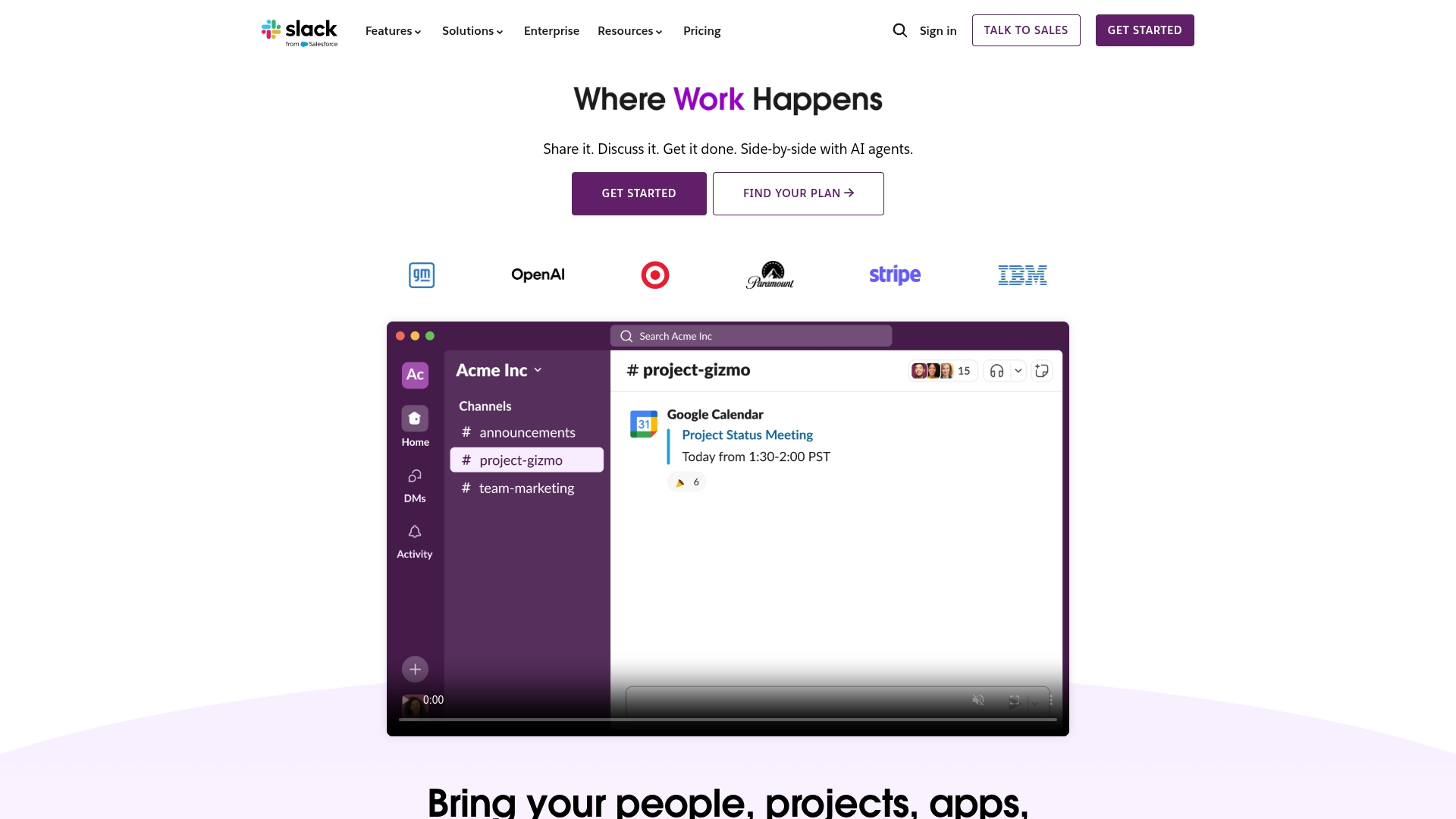
Best for: Teams that need to centralize communication and integrate multiple software tools into one collaborative workspace.
Key features:
- Channel organization for project-specific conversations and file sharing
- Workflow Builder for automating routine tasks without coding
- Extensive integration ecosystem with over 2,600 apps including Google Drive, Asana, and Salesforce
Pricing:
- Free: $0 (90 days message history, up to 10 app integrations)
- Pro: $7.25/month per user (annual billing) or $8.75/month (monthly billing)
- Business+: $15/month per user (annual billing) or $18/month (monthly billing)
- Enterprise+: Contact sales for pricing
- 50% discount for 3 months available for new teams
Considerations:
- Mobile app performance issues with reported bugs and synchronization problems
- Can become overwhelming with information overload from constant notifications and messages
15. Adobe Workfront
Adobe Workfront delivers enterprise-grade work management that transforms complex marketing and creative workflows into streamlined operations. The platform specializes in connecting strategic planning to execution across large organizations, making it ideal for marketing teams, agencies, and enterprises managing sophisticated campaigns and creative assets.
Best for: Large enterprises and marketing teams that need robust workflow automation, resource management, and deep integration with Adobe’s creative ecosystem.
Key features:
- Enterprise planning with campaign orchestration and strategic alignment tools
- Automated review and approval workflows with digital proofing capabilities
- AI-powered project health assessment and workflow acceleration features
Pricing:
- Custom pricing available upon request
- No publicly available pricing tiers
Considerations:
- Steep learning curve and complex interface that requires significant training investment
- High cost structure makes it less suitable for small to medium-sized businesses
Adobe Workfront positions itself as the marketing system of record, offering comprehensive project portfolio management that scales across departments. The platform excels at managing the entire creative lifecycle from brief creation to final asset delivery, with enterprise-grade security and compliance features that regulated industries require.
The software’s integration with Adobe Creative Cloud and Experience Cloud creates a unified ecosystem where creative teams can access project priorities directly within their design tools. This seamless connection eliminates the typical friction between creative work and project management, allowing marketing teams to maintain momentum from concept through execution.
Workfront’s automation capabilities extend beyond basic task management to include sophisticated workflow triggers, resource allocation based on skills and capacity, and AI-driven insights that help predict project outcomes. For large organizations managing multiple campaigns simultaneously, these features provide the visibility and control needed to keep complex initiatives on track while maintaining quality standards.
16. ActiveCollab
ActiveCollab delivers an all-in-one project management platform that combines task management, time tracking, and client billing in a single workspace. The platform specializes in serving service businesses and creative agencies that need to manage projects from initial concept to final payment. With over 50,000 paying customers across 200+ countries, ActiveCollab has built a reputation for its user-friendly interface and comprehensive feature set.
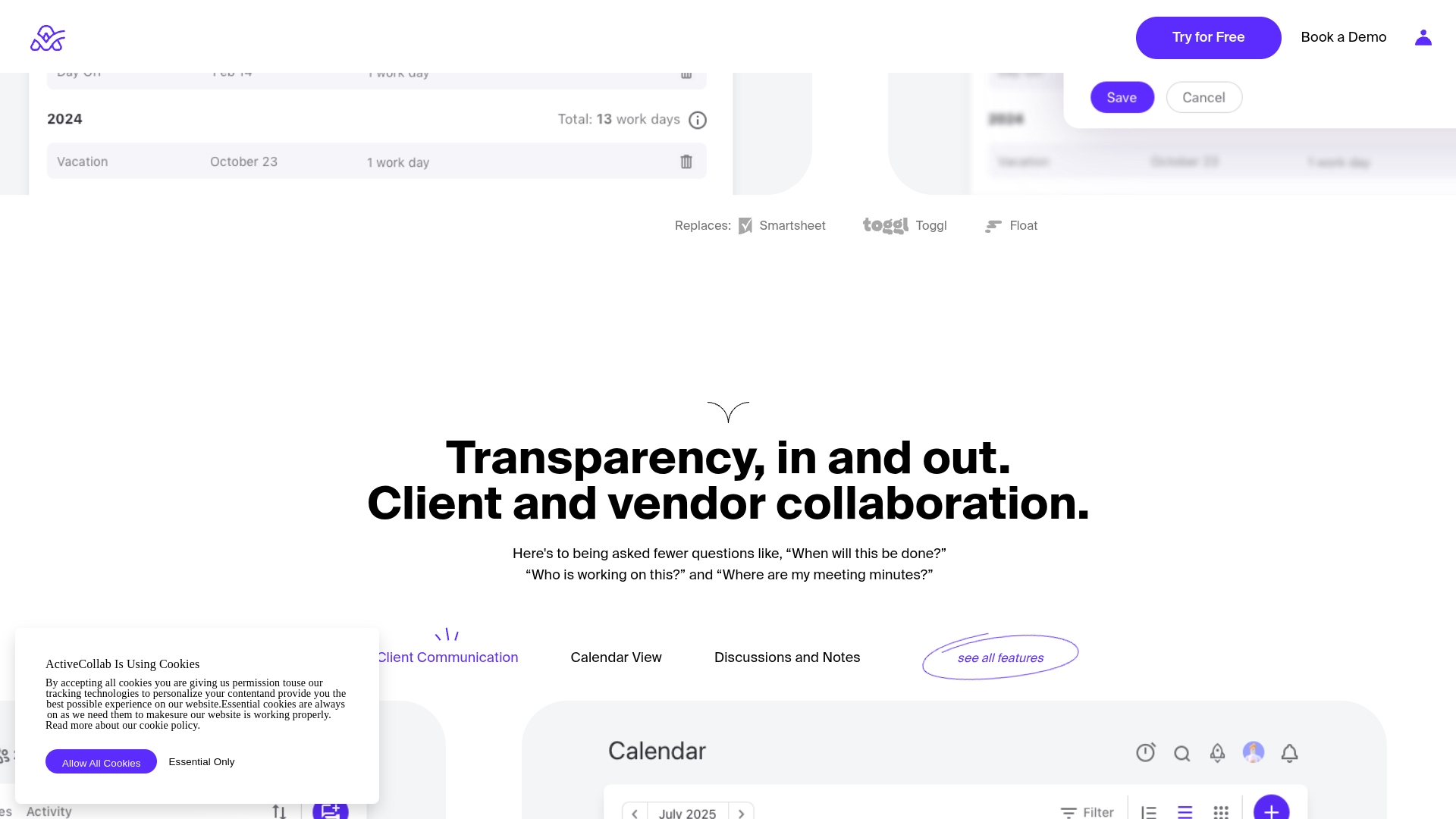
Best for: Service businesses and creative agencies that need integrated project management, time tracking, and invoicing capabilities in one platform.
Key features:
- Task management with multiple views including Kanban boards, Gantt charts, and timeline views
- Built-in time tracking with stopwatch functionality for accurate project billing
- Comprehensive invoicing system with online payment processing and expense tracking
Pricing:
- Pricing information was not available in the provided research
Considerations:
- Cannot assign a single task to multiple team members, which may limit workflow flexibility for some teams
- Mobile application lacks some features compared to the desktop version, potentially affecting productivity for remote workers
17. Nifty
Nifty pulls roadmaps, tasks, docs, files, and team chat into one friendly workspace, so we can stop juggling half-a-dozen apps and get back to the work that matters. Its milestone-driven automation keeps everyone laser-focused on outcomes, while real-time collaboration (chat, docs, comments, calls) makes remote and cross-functional teams feel like they’re in the same room.
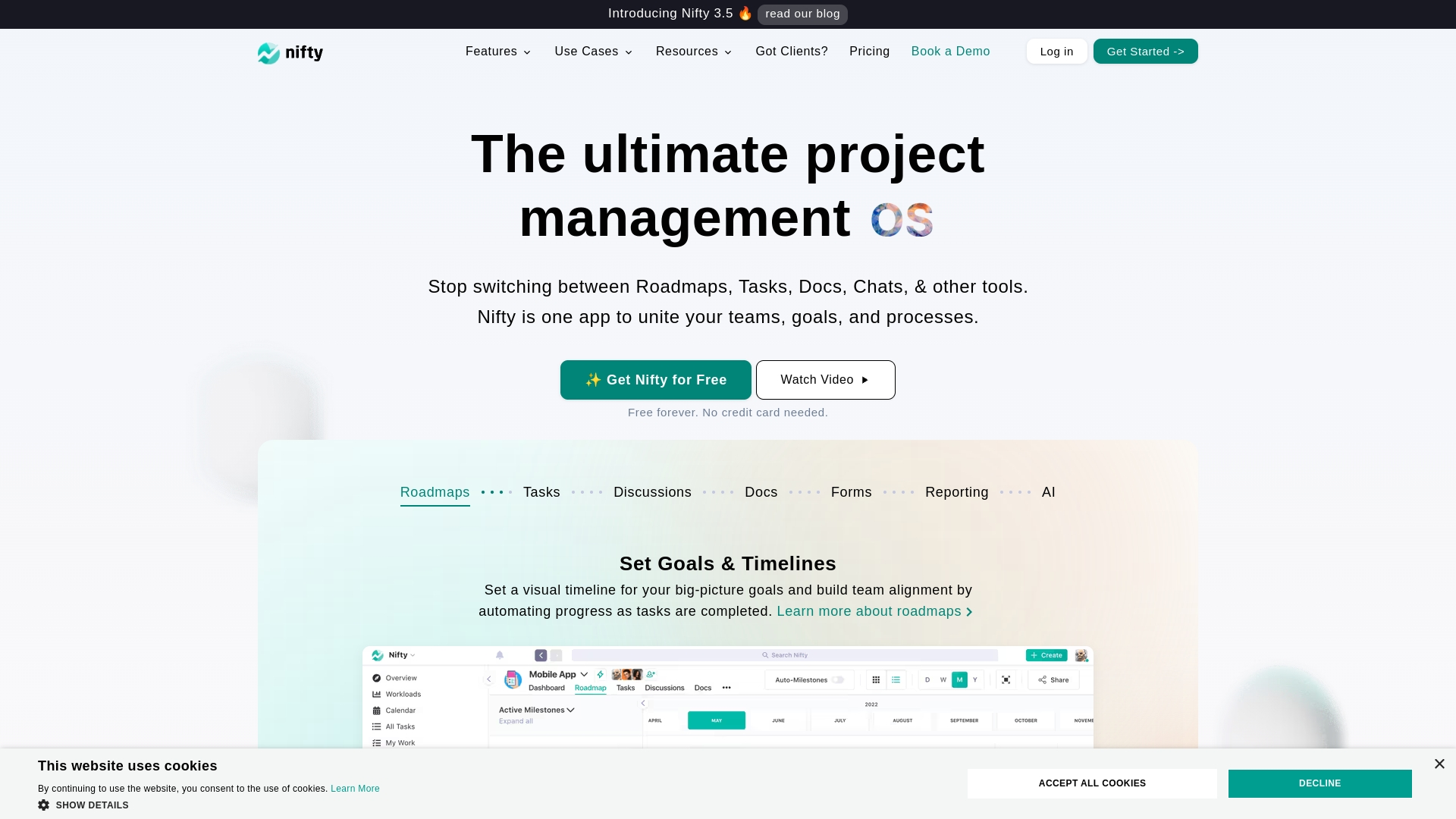
Best for: Creative agencies, product, engineering, marketing, sales, IT, legal, and any remote or hybrid team that wants one platform for planning, work execution, docs, and client collaboration (B2B, B2C, or internal).
Key features
- Milestone-driven progress automation that ties task completion directly to project goals
- Multiple views (Kanban, Gantt, List, Swimlane, Calendar) plus Cross-Project Overview dashboards
- Docs & Files hub with a native doc editor and Google Docs/Drive integration
- Built-in chat, project discussions, file proofing, and one-click video calls
- Time tracking & reporting, budget tracking, and workload management
- Custom workflow automations (if/then rules) and Orbit AI for summaries and smart suggestions
- Supports Agile, Waterfall, and Critical Path methodologies out of the box
- Robust security: Two-Factor Authentication, SSO (Google/Microsoft), SAML (Enterprise), IP restriction
Pricing
- Free – $0 forever
- Personal – $7 per member
- Pro – $10 per member
- Business – $16 per member
- Enterprise – Contact sales
Considerations
- Mobile app is handy for quick check-ins but lacks the depth of the desktop experience.
- Dashboard and report customization is improving but still trails some long-time enterprise rivals.
18. Height
Height offered autonomous project management powered by AI to streamline development workflows. The platform specialized in automating routine tasks like bug triage and backlog grooming, making it ideal for tech teams seeking to eliminate administrative overhead. However, Height announced it will discontinue operations on September 24th, 2025, making it unsuitable for new users.
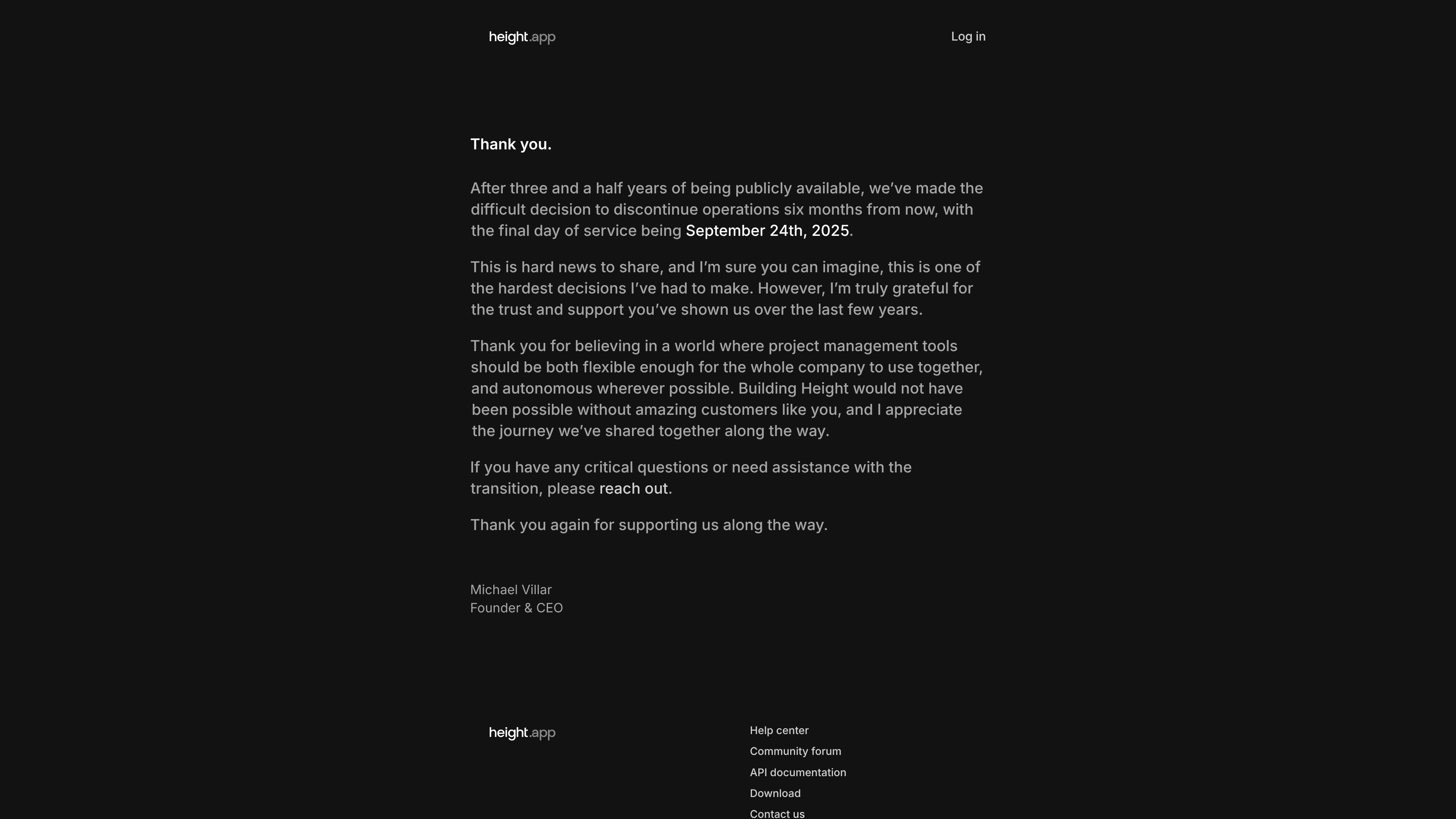
Best for: Development teams looking for AI-powered project management that automates administrative tasks and provides flexible project visualization.
Key features:
- AI-powered “Copilot” that automates bug triage, backlog refinement, and status updates
- Multiple project views including Kanban, Gantt, spreadsheet, and calendar formats
- Integrated chat within tasks to centralize project-related communication
Pricing:
- Basic: $0/month for up to 10 members with 2 teams and 1,000 active tasks
- Core: $15/member per month with 5 teams and unlimited active tasks
- Business: $24/member per month with unlimited teams and advanced controls
- Enterprise: Custom pricing for organizations with 500+ members
- Annual billing offers 20% discount
Considerations:
- Service discontinuation scheduled for September 24th, 2025, requiring immediate migration planning
- Mobile app layout differs significantly from web version, creating inconsistent user experience
Key factors to consider when selecting B2B systems
Selecting the right B2B platform means finding a long-term partner that supports how your team works today and how it will grow tomorrow. The right system simplifies complex processes, keeps collaboration consistent, and adapts as your organization changes.
When evaluating platforms, focus on three areas:
- Integration: The platform should connect with the tools you already use and allow flexibility for future integrations. Information should flow freely across departments, without silos.
- Security and compliance: Enterprise-ready software must safeguard your organization’s data. Prioritize systems with enterprise-grade security features like encryption, multi-factor authentication, and certifications such as SOC 2 and ISO 27001.
- Scalability: As your organization adds people, departments, or regions, the platform should make onboarding and expansion simple while keeping workflows consistent.
The strongest platforms are the ones that reduce complexity and create confidence that the system will continue to support every stage of growth.
How AI enhances B2B enterprise software
AI changes how enterprises manage work by automating repetitive tasks, identifying patterns, and surfacing insights before issues escalate. Teams gain time back from manual updates and leaders gain clarity to make better decisions.
In monday work management, AI capabilities include:
- Generating project plans with suggested tasks and milestones
- Summarizing meetings with clear action items and next steps
- Flagging risks across portfolios so they can be addressed early
- Analyzing opportunities to predict which deals are most likely to close
By handling updates, categorizing requests, and forecasting challenges, AI allows teams to focus on strategic and high-impact work. The result is faster execution with less effort and more accuracy.
Try monday work managementBest practices for seamless integration
Integrating a new platform is an opportunity to redesign how your organization works. Success depends on preparing data, aligning people, and approaching rollout in phases.
Plan your data migration
Data forms the foundation of every process. Before moving it into a new platform, identify the workflows that need to migrate and decide what to leave behind.
Steps for a clean migration:
- Begin with active projects instead of transferring everything at once
- Map connections so tasks, timelines, and ownership remain intact
- Remove duplicates and outdated records before import
The import tools in monday work management link existing tasks, timelines, and teams with minimal effort. Rolling out in phases gives teams a chance to adjust with real projects in place.
Get everyone on the same page
Technology creates value when teams see how it improves their work. Adoption grows when people understand how the platform reduces effort and provides clarity.
Ways to build momentum:
- Appoint department champions to guide training and answer questions
- Use real projects in training sessions so the benefits are visible immediately
- Expand adoption gradually to create early wins and build confidence
When teams experience the value directly—whether through marketing campaigns visualized in minutes or operations teams tracking requests without email chains—adoption follows naturally.
Turn scattered processes into connected progress
The real impact of the right platform is turning scattered work into streamlined wins. Silos break down, email chains disappear, and teams gain a single, clear view of progress. Cross-functional projects stop feeling like a puzzle and start moving forward with clarity.
When workflows are consistent and repeatable, scaling becomes straightforward. Routine tasks are automated, giving people more time to focus on the work that drives results. With visibility into plans and outcomes, every team member understands their role and contribution—building momentum that carries the entire organization forward.
Now is the time to experience that transformation for yourself. Start by connecting one team’s work, then expand across your organization as adoption grows. With monday work management, you’ll see how quickly scattered processes align into one connected system built for scale.
Try monday work managementFAQs
What are the 4 types of B2B software?
B2B software typically fall into four groups: operational, relationship management, collaborative, and analytical. Many enterprise solutions bring these categories together so teams can manage work in one connected system.
How does B2B software differ from B2C software?
B2B platforms are built for organizations. They emphasize collaboration, integrations, and security, while B2C software focuses on individual use.
What industries benefit most from B2B SaaS solutions?
While nearly every industry benefits, sectors like technology, healthcare, finance, and manufacturing see massive gains from B2B SaaS. These sectors depend on software that can manage complex processes across multiple teams.
How secure are cloud-based B2B software platforms?
Leading platforms offer enterprise-grade security that often surpasses a company’s internal capabilities, featuring robust encryption and multi-factor authentication. They maintain compliance with global standards, such as SOC 2 and ISO 27001, to ensure your data remains safe.
What is the average implementation time for B2B SaaS platforms?
Implementation varies by organization, but many teams begin seeing value within days. Intuitive setup and pre-built templates reduce the time to adoption.
How do I evaluate the ROI of B2B software investments?
To evaluate ROI, measure quantifiable improvements like increased productivity, faster project completion, and reduced errors. Also, factor in cost savings from eliminating manual tasks and lowering IT overhead.
 Get started
Get started 

